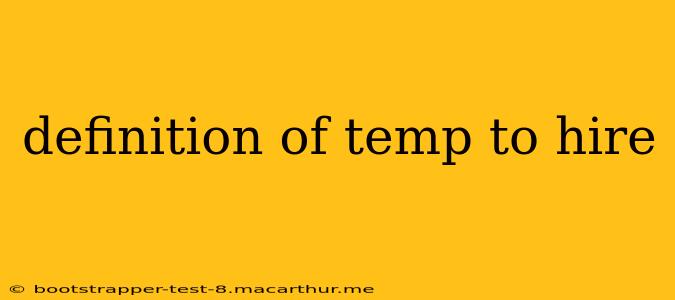Temp-to-hire, also known as temporary-to-permanent employment, is a hiring process where a company initially hires a temporary employee through a staffing agency or directly. The employee works for a set period, typically ranging from a few weeks to several months, during which both the employer and the employee assess the suitability of the working relationship. If both parties are satisfied, the temporary employee is then offered a permanent, full-time position within the company. This approach offers flexibility and reduced risk for both employers and employees.
What are the benefits of temp-to-hire for employers?
This hiring strategy presents several advantages for businesses:
- Reduced Hiring Risk: Employers can evaluate a candidate's skills and work ethic in a real-world setting before committing to a long-term employment contract. This minimizes the risk of making a bad hire and the associated costs.
- Flexibility and Scalability: Temp-to-hire allows companies to easily adjust their workforce based on fluctuating demands. They can quickly bring in temporary help during busy periods or for specific projects and then transition suitable candidates to permanent roles if needed.
- Access to a Wider Talent Pool: Staffing agencies often have access to a wider pool of candidates than a company might reach through traditional recruitment methods. This allows employers to find skilled individuals who might not actively be seeking a permanent position.
- Cost Savings (Potentially): While there are costs associated with using a staffing agency, there can be savings in the long run by avoiding the costs associated with a poor hire.
- Testing the Waters: It allows the employer to see how well the employee fits into the company culture before a long-term commitment is made.
What are the benefits of temp-to-hire for employees?
Temp-to-hire arrangements also offer several benefits to job seekers:
- Gaining Experience: It provides valuable work experience in a specific field or company, strengthening a candidate's resume and enhancing their skills.
- Foot in the Door: It serves as a pathway to secure a permanent position within a desirable company. It allows candidates to demonstrate their capabilities and build rapport with potential long-term employers.
- Assessing Company Culture: Before committing to a full-time role, candidates can evaluate the company culture, work environment, and team dynamics.
- Improved Job Security (Potentially): Once a temp employee transitions to a permanent position, they gain the stability and security of a long-term contract.
- Negotiating Power: Having proven themselves as a valuable temporary employee may give the candidate more negotiating power regarding salary and benefits when offered a permanent position.
What is the difference between temp and temp-to-hire?
The key difference lies in the intention and duration of the employment. A temporary job is a short-term assignment with a defined end date, and there's no expectation of a permanent position. In contrast, temp-to-hire implies a potential for permanent employment after a successful probationary period. The temporary phase is a trial period for both parties to assess compatibility.
How long does a temp-to-hire position typically last?
The duration of the temporary phase in a temp-to-hire arrangement can vary significantly depending on the role, industry, and company policies. It typically ranges from a few weeks to several months, often aligning with the completion of a specific project or the end of a busy season.
How does the transition to permanent employment work?
The transition process usually involves a formal offer of permanent employment from the employer. This offer will typically include details about salary, benefits, and other terms of employment. The specifics of the transition will vary depending on the company and the staffing agency involved (if applicable).
What are the drawbacks of temp-to-hire?
While temp-to-hire offers many advantages, it's important to acknowledge potential drawbacks:
- Uncertainty: The lack of guaranteed long-term employment during the temporary phase can create uncertainty and stress for the employee.
- Lower Pay: Temporary positions often come with lower pay and fewer benefits compared to permanent positions.
- Limited Benefits: Temporary employees may not be eligible for the same benefits as permanent employees, such as health insurance or paid time off.
- Potential for Non-Conversion: There's no guarantee that a temporary employee will be offered a permanent position, even if they perform well.
Temp-to-hire employment is a strategic approach that balances flexibility and risk management for employers while providing valuable work experience and potential career advancement for employees. Understanding the intricacies of this process can be beneficial for both sides in navigating the transition successfully.
